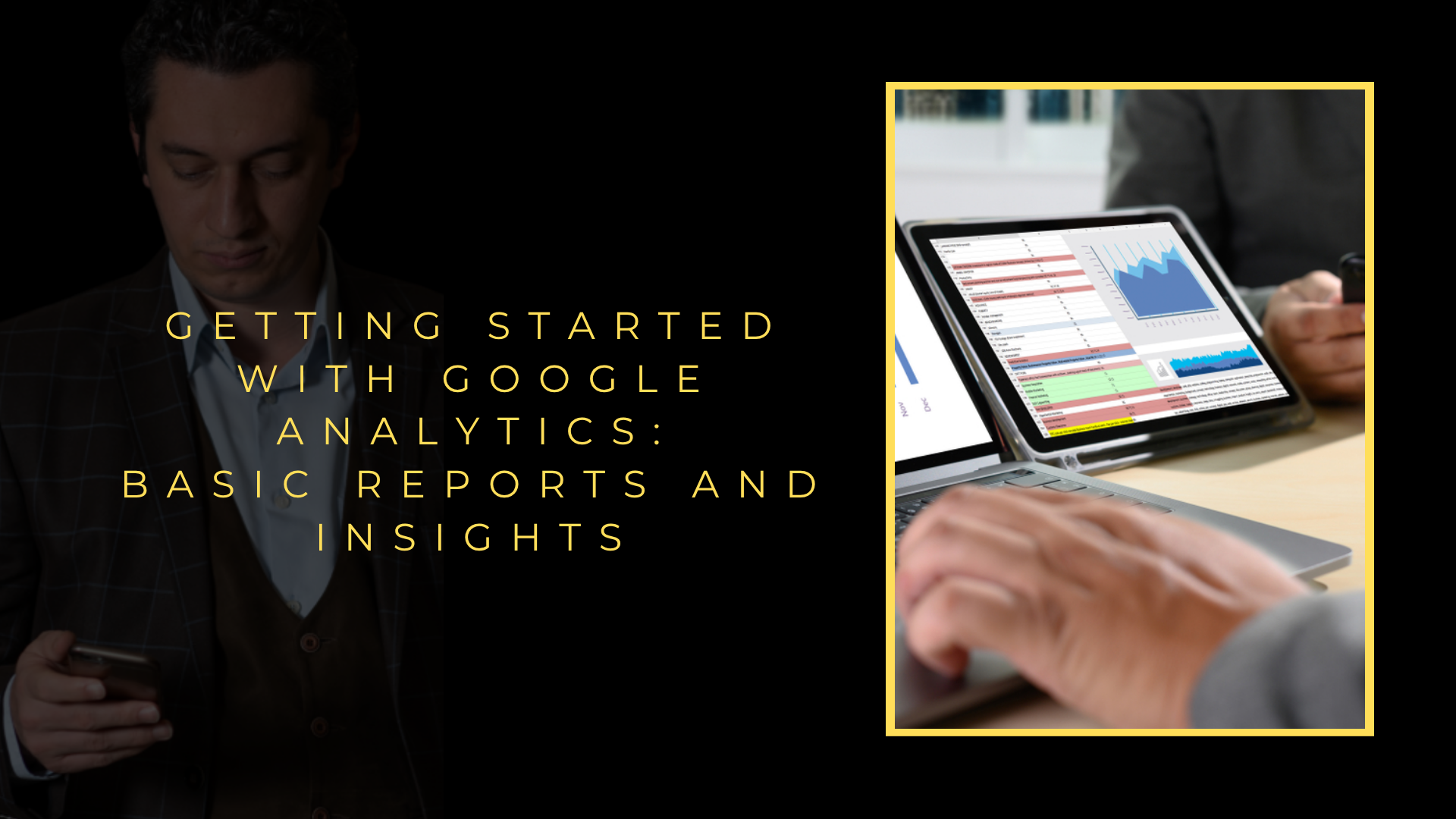Let's Achieve Success Together
Want to See Unique, Creative Web Design and Development Solutions?
Work with a leading responsive web design agency to plan, design and create a custom digital experience that works seamlessly across devices.


For industrial engineers and product managers entering the digital realm, Google Analytics presents a powerful data acquisition tool, transforming raw user interactions into actionable intelligence. The initial challenge is navigating the interface to find the signals amidst the noise. A focused approach on five foundational reports provides immediate clarity on user behavior and website performance.
The Acquisition Overview report is the critical starting point, revealing the origin of your website traffic. This report answers the fundamental commercial question: which channels—be it organic search, paid ads, or referrals from industry partners—are driving qualified visitors to your technical specifications or product documentation. Understanding these traffic sources allows for strategic reallocation of marketing resources toward the most effective channels.
Once traffic arrives, the Behavior Flow report visualizes the user's journey through the site. For a complex industrial site, this highlights where engineers might be getting stuck in a product configuration tool or where commercial visitors drop off before reaching the contact form. Identifying these user engagement bottlenecks is essential for optimizing the conversion funnel and improving the overall user experience.
The Landing Pages report identifies which specific pages are the primary entry points. For a company like Serdar Gürsoy, this could reveal that a technical whitepaper on a specific material is a major draw. This insight directly informs content strategy, suggesting that creating more deep-dive content on popular topics can attract a highly targeted audience and generate more qualified leads.
Complementing this, the Events report tracks specific interactions that don't involve a page load, such as downloads of a PDF datasheet, clicks on a "request a quote" button, or video views of a product demo. This granular data acquisition is invaluable for measuring engagement with key assets and understanding the intent of your visitors beyond simple page views.
The Audience Demographics report provides a layer of context about the users themselves. Knowing the geographic location, industry, or interests of your audience allows for more precise targeting in future campaigns and helps tailor the website's messaging to resonate with its core commercial and technical visitors.
The implementation of a robust data analytics framework is critical for industrial and commercial operations seeking to optimize digital performance. For product managers and engineers, Google Analytics provides a foundational system for transforming user interactions into actionable intelligence. The initial setup process, as detailed by Serdar Gürsoy, is a strategic exercise in configuration that establishes the integrity of all subsequent data collection.
Proper implementation begins with creating a property within the Google Analytics interface, which acts as the container for data from a specific digital asset, such as a corporate website or a customer portal for industrial equipment. This step requires careful consideration of the data stream, defining the exact source of user traffic. A crucial technical task involves embedding the provided tracking code directly into the website's HTML, a process that demands precision to ensure comprehensive data capture across all pages.
Once the code is deployed, the focus shifts to verification to confirm that data is flowing correctly into the reports. This validation step is essential for establishing a reliable baseline against which future performance can be measured. The core dashboard then becomes the central interface, presenting key metrics like user acquisition channels, engagement rates, and conversion events.
For commercial decision-makers, this data directly informs resource allocation and strategic planning. Understanding which technical documents or product pages are most frequently accessed by engineers can guide content development and support infrastructure investments. The ability to track user journeys from initial contact through to a request for a quote or a white paper download provides unparalleled insight into the effectiveness of marketing efforts and the interests of a highly specialized audience.
A correctly configured analytics system moves beyond simple web traffic counting to become a diagnostic tool for the entire digital customer experience. It enables product teams to identify friction points in informational pathways and engineers to understand how stakeholders interact with technical specifications, leading to more informed product development and a stronger market position.
GA4 marks a fundamental shift in the underlying data structure and reporting mechanisms, positioning the platform to use a more flexible, event-based QQ3">data collection model compared to the session-based approach of Universal. This evolution is critical for industrial engineers and product managers who require a holistic view of the entire user journey across multiple platforms, as it allows for a more accurate measurement of complex user engagement.
The core reporting in GA4 is built around the concept of event-driven analytics, where every interaction is captured as a discrete. This contrasts with the session-centric model of , which groups interactions within a given timeframe. For commercial decision-makers, the GA4 model provides superior cross-platform measurement, enabling a data-driven understanding of how users interact with a brand across web, mobile apps, and the emerging Internet of Things.
A significant technical advantage. advantage of GA4 is its enhanced capability for user-centric analysis. The platform leverages an improved attribution model that provides a more data-driven view of the customer journey. This allows for a deeper analysis of customer behavior across multiple touchpoints.

For industrial engineers and product managers, website performance transcends mere traffic volume, demanding a focus on metrics that directly correlate with commercial outcomes and operational efficiency. The foundational Key Performance Indicators (KPIs) within Google Analytics provide the quantitative backbone for these assessments, transforming raw data into actionable business intelligence.
Understanding user origin and behavior begins with analyzing Traffic Sources. This metric reveals whether visitors arrive via organic search, paid campaigns, or direct links, enabling commercial leaders to allocate marketing budgets effectively. For technical products, a high volume of traffic from targeted organic searches often indicates strong market presence and effective Search Engine Optimization (SEO) for relevant industrial terms.
Engagement is paramount, measured by User Engagement metrics like average session duration and pages per session. A visitor spending significant time on technical specification sheets or whitepapers signals high-quality interest, a crucial leading indicator for the sales funnel. This data helps product managers identify which content resonates with a professional audience.
The ultimate measure of a website's commercial effectiveness is its Conversion Rate. Whether the goal is a downloaded technical datasheet, a request for a quote, or a contact form submission, this metric quantifies the percentage of visitors who complete a desired action. Optimizing the User Journey to minimize friction and guide engineers toward these conversions is a primary application of this data.
To gain deeper insights, savvy analysts employ Segmentation, isolating traffic from specific industries or comparing behavior from new versus returning visitors. Furthermore, identifying pages with high Bounce Rates can pinpoint where the user experience fails to meet the expectations set by the initial traffic source, allowing for targeted improvements.
For complex industrial sales cycles, tracking Goal Completions across multiple touchpoints is essential. By establishing a sequence of micro-conversions, such as viewing a case study before downloading a brochure, companies can model the Sales Funnel and identify drop-off points that require intervention, as noted by industry expert Serdar Gürsoy.
For industrial engineers and product managers, the transition from physical process optimization to digital performance represents a significant opportunity, and Serdar Gürsoy's guide provides the essential framework for this evolution.
The guide's focus on the Acquisition report is critical for commercial leaders, as it breaks down which marketing channels—be it organic search, paid campaigns, or referrals—drive qualified traffic to industrial websites, allowing for precise budget allocation and ROI calculation on marketing spend.
Understanding user Behavior is paramount; the guide details how to analyze the Behavior Flow report to see the paths users take through a site, identifying friction points in the journey from a product specification page to a contact form, which is analogous to optimizing a production line for efficiency.
The Conversion tracking methodologies outlined are indispensable for measuring tangible business outcomes, such as form submissions for technical whitepapers or requests for product demonstrations, directly linking web activity to sales pipeline generation.
Effective Attribution modeling, a key topic in the guide, moves beyond last-click analysis to assign value to all touchpoints in a complex B2B sales cycle, providing a more accurate picture of how digital interactions influence commercial decisions.
By implementing the segmentation strategies recommended, analysts can isolate data for specific visitor groups, such as those from a particular industry or geographic region, enabling highly targeted product development and marketing communications.
The guide emphasizes establishing a clear Data Layer for advanced tracking, which is fundamental for capturing specific interactions on dynamic industrial websites, like interactions with configurators or downloads of CAD files, ensuring data integrity.
The resource empowers teams to move from reactive reporting to proactive Optimization, using data-driven insights to continuously refine the digital user experience, reduce bounce rates on technical content, and increase lead quality.
This approach transforms web analytics from a simple reporting tool into a strategic asset for Performance Marketing, aligning digital efforts with overarching business objectives for sustainable growth.
For industrial engineers and product managers, the transition from physical product data to digital user behavior analytics can be daunting. Google Analytics provides a wealth of information, but its raw output is often overwhelming. The practical guide by Serdar Gürsoy addresses this by framing data interpretation as a process of industrial performance metrics, translating abstract numbers into actionable engineering insights.
The core value lies in establishing a clear data-driven decision-making framework. Instead of reporting mere page views, the guide teaches how to correlate specific website actions, such as downloading a technical whitepaper or accessing a product configurator, with stages in the commercial funnel. This approach transforms a company website from a static brochure into a dynamic conversion tracking system for high-value leads.
Technical teams will appreciate the focus on traffic source attribution, which functions like supply chain traceability. Understanding whether qualified visitors originate from technical forums, industry publications, or paid search campaigns allows for precise optimization of marketing resource allocation. This is critical for commercial decision-makers who need to justify digital spend with the same rigor as capital expenditure.
A key technical application involves analyzing user engagement with complex content. For instance, time spent on a page detailing a new environmental remediation technology, combined with scroll depth analysis, serves as a powerful proxy for prospect interest level. This behavioral analytics data helps product managers prioritize features that resonate most with the target market.
Furthermore, the guide emphasizes the importance of setting a measurement framework with defined Key Performance Indicators (KPIs) from the outset. This ensures that every data point collected ties directly to a business objective, such as reducing cost-per-acquisition for industrial clients or increasing engagement with technical support materials. This structured approach prevents analysis paralysis and focuses efforts on the most impactful performance metrics.
Serdar Gürsoy's methodology enables a continuous feedback loop. By systematically interpreting analytics data, engineering and commercial teams can iteratively refine their digital presence, optimize the lead generation process, and make informed strategic decisions based on empirical evidence of user behavior, thereby aligning digital strategy with overarching industrial and environmental business goals.
Contents


Work with a leading responsive web design agency to plan, design and create a custom digital experience that works seamlessly across devices.
Contact Form
Fill out the form and we will contact you as quickly as possible.
Whatsapp'tan Bize Ulaşın.
Bir konuşma başlatmak için kamera uygulamanızla tarayın veya QR kodunu tıklayın.
Lorem Ipsum, dizgi ve baskı endüstrisinde kullanılan mıgır metinlerdir. Lorem Ipsum, adı bilinmeyen bir matbaacının bir hurufat numune kitabı oluşturmak üzere bir yazı galerisini alarak karıştırdığı 1500'lerden beri endüstri standardı sahte metinler olarak kullanılmıştır. Beşyüz yıl boyunca varlığını sürdürmekle kalmamış, aynı zamanda pek değişmeden elektronik dizgiye de sıçramıştır. 1960'larda Lorem Ipsum pasajları da içeren Letraset yapraklarının yayınlanması ile ve yakın zamanda Aldus PageMaker gibi Lorem Ipsum sürümleri içeren masaüstü yayıncılık yazılımları ile popüler olmuştur.
Yinelenen bir sayfa içeriğinin okuyucunun dikkatini dağıttığı bilinen bir gerçektir. Lorem Ipsum kullanmanın amacı, sürekli 'buraya metin gelecek, buraya metin gelecek' yazmaya kıyasla daha dengeli bir harf dağılımı sağlayarak okunurluğu artırmasıdır. Şu anda birçok masaüstü yayıncılık paketi ve web sayfa düzenleyicisi, varsayılan mıgır metinler olarak Lorem Ipsum kullanmaktadır. Ayrıca arama motorlarında 'lorem ipsum' anahtar sözcükleri ile arama yapıldığında henüz tasarım aşamasında olan çok sayıda site listelenir. Yıllar içinde, bazen kazara, bazen bilinçli olarak (örneğin mizah katılarak), çeşitli sürümleri geliştirilmiştir.
Yaygın inancın tersine, Lorem Ipsum rastgele sözcüklerden oluşmaz. Kökleri M.Ö. 45 tarihinden bu yana klasik Latin edebiyatına kadar uzanan 2000 yıllık bir geçmişi vardır. Virginia'daki Hampden-Sydney College'dan Latince profesörü Richard McClintock, bir Lorem Ipsum pasajında geçen ve anlaşılması en güç sözcüklerden biri olan 'consectetur' sözcüğünün klasik edebiyattaki örneklerini incelediğinde kesin bir kaynağa ulaşmıştır. Lorm Ipsum, Çiçero tarafından M.Ö. 45 tarihinde kaleme alınan "de Finibus Bonorum et Malorum" (İyi ve Kötünün Uç Sınırları) eserinin 1.10.32 ve 1.10.33 sayılı bölümlerinden gelmektedir. Bu kitap, ahlak kuramı üzerine bir tezdir ve Rönesans döneminde çok popüler olmuştur. Lorem Ipsum pasajının ilk satırı olan "Lorem ipsum dolor sit amet" 1.10.32 sayılı bölümdeki bir satırdan gelmektedir.
1500'lerden beri kullanılmakta olan standard Lorem Ipsum metinleri ilgilenenler için yeniden üretilmiştir. Çiçero tarafından yazılan 1.10.32 ve 1.10.33 bölümleri de 1914 H. Rackham çevirisinden alınan İngilizce sürümleri eşliğinde özgün biçiminden yeniden üretilmiştir.
Lorem Ipsum pasajlarının birçok çeşitlemesi vardır. Ancak bunların büyük bir çoğunluğu mizah katılarak veya rastgele sözcükler eklenerek değiştirilmişlerdir. Eğer bir Lorem Ipsum pasajı kullanacaksanız, metin aralarına utandırıcı sözcükler gizlenmediğinden emin olmanız gerekir. İnternet'teki tüm Lorem Ipsum üreteçleri önceden belirlenmiş metin bloklarını yineler. Bu da, bu üreteci İnternet üzerindeki gerçek Lorem Ipsum üreteci yapar. Bu üreteç, 200'den fazla Latince sözcük ve onlara ait cümle yapılarını içeren bir sözlük kullanır. Bu nedenle, üretilen Lorem Ipsum metinleri yinelemelerden, mizahtan ve karakteristik olmayan sözcüklerden uzaktır.
 Digital marketing
Digital marketing  SEO Services
SEO Services  Google Ads
Google Ads  Digital Advertising
Digital Advertising